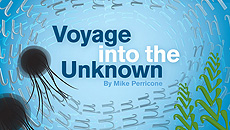Voyage into the unknown
 |
In the deep, dark quantum sea known as the Intensity Frontier, particle physicists expect to find everything from exotic new particles to new insights into the evolution of our universe. |
At their darkest depths, the Earth's oceans have given rise to life forms foreign enough to have come from other worlds. Scientists have discovered life that exists without light, bacteria that feast on foul-smelling chemicals fatal to humans, and colonies of giant clams and tubeworms that thrive in vents hotter than 400 degrees. The forms of life that scientists have observed in these alien ocean realms are stranger than anything in our imaginations.
The depths of the quantum seas harbor their own surprising creatures. Probing the secrets of the subatomic world, physicists have found stealth neutrinos that traverse the Earth without leaving a trace, colorful quarks that form a zoo of short-lived denizens and massive bosons that break fundamental concepts of nature such as left-right symmetry. And they know there is more to discover. The known particles account for less than one twentieth of the entire mass and energy of the universe.
In a research effort known as the Intensity Frontier, scientists are embarking on a voyage into the deepest, darkest recesses of the subatomic realm. What will they see when they shine their most intense particle beams ever at the dark, unknown and unexplored quantum universe? Will their large, massive particle detectors make discoveries that prove even more strange and startling than those made in the past?
"No one has been there before," says SLAC National Accelerator Laboratory's JoAnne Hewett, who co-leads US efforts to map out research opportunities at the Intensity Frontier. "There are certain to be some things we expect to see. But some things will be completely unexpected and could change our view of how the universe works."
By probing the subatomic depths with intense particle beams and super-massive detectors, scientists hope to find undercurrents of strange new particles and behaviors in the uncharted waters called "new physics."
"We know that there is new physics out there, and we know that there are particles and interactions that are not part of the Standard Model," says Argonne National Laboratory's Harry Weerts, who together with Hewett co-chaired an Intensity Frontier workshop last fall. "Only a few percent of the universe is made of matter like us. We think we should be able to explain why, but so far we haven't been able to. With very intense particle beams and large detectors, we will be able to look for the very rarest of processes."
Read more
—Mike Perricone
|